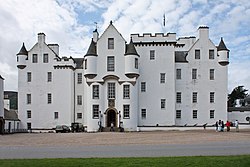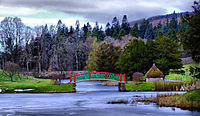Blair Castle
| Blair Castle | |
|
Perthshire | |
|---|---|

| |
| Location | |
| Grid reference: | NN865662 |
| Town: | Blair Atholl |
| History | |
| Information | |
| Website: | blair-castle.co.uk |
Blair Castle stands by the wee town of Blair Atholl in the Highlands of Perthshire. It is the most famous and by far the grandest feature of the town and one of the premier stately homes of the Highlands. Blair Castle is also the last castle in the British Isles to have been besieged, which took place in 1746 during the last Jacobite Rebellion. The Castle was the traditional home of the Earls (later Marquesses, now Dukes) of Atholl, albeit that the current Duke resides abroad.
Queen Victoria was a guest at Blair Castle and so charmed that she bestowed upon the Duke of Atholl a unique privilege: he is the only person in the United Kingdom allowed to raise a private army. This army, the Atholl Highlanders, conducts largely social and ceremonial activities, and primarily consists of workers on the extensive Atholl Estates.
The castle is now held on a trust created by the 10th Duke, George Iain Murray (1931–96), in his will. His title was inherited by a distant cousin the 11th Duke, John Murray (1929-2012), who lived in South Africa, and visited annually to review the Atholl Highlanders. The 12th Duke, his son is also South African and resident there.
Structure
The oldest part of Blair Castle, known as Comyn's (or Cumming's) Tower, a small tower-house with immensely thick walls, is claimed (perhaps dubiously) to date from as early as the 13th century. The majority of the Castle is 16th century in date, though much altered. After the siege in the '45 Rebellion, the upper storey and battlements of the ancient castle were removed to render it indefensible.
A mediæval appearance becoming fashionable once more during the 19th century, the Castle, which had become known as Atholl House, was raised in height and adorned with battlements once more. The many alterations in the fabric are largely concealed by the white harling (roughcast) on the walls. The collections of furniture, paintings, historical relics, weapons, embroidery, china, Highland artefacts and hunting trophies preserved in the Castle are among the finest in the land, as is the plasterwork and other décor of the principal rooms. Thirty-two rooms are open to the public, more than in any comparable stately home.
The grounds

The castle stands in extensive grounds, which the Dukes of Atholl have altered and added to over several centuries. Notable among the features are Diana's Grove and the Hercules Garden, both laid out in the first half of the 18th century, and rare examples of their period. Both are adorned with lead reproductions of Classical statues. The Dukes of Atholl were early and enthusiastic tree planters, and Diana's Grove contains some of the tallest trees in Great Britain. The Hercules Garden, recently restored, is a rare survival of a walled formal garden with an artificial lake and islands, surrounded by plantations of fruit trees. There are several other follies, bridges etc. of various periods.
Old Blair
Within the Castle grounds is the hamlet and former parish church of Old Blair (NN867666), the original focus of settlement in the area before the present village, which was laid out from the first half of the 19th century. The church was dedicated to St Bride and is a probable early Christian site. John Graham of Claverhouse, Viscount Dundee, 'Bonnie Dundee' was buried in the aisle attached to the now roofless church after the Battle of Killiecrankie, 27 July 1689. The modern railed burial enclosure of the family of the Dukes adjoins the ancient unenclosed churchyard. In the Middle Ages the main road from Atholl to Badenoch, and hence to the north, passed through this village and the Minigaig Pass.
Events
In 1946 the first Blair Atholl International Scout Jamborette was held within the castle grounds. This Scout Camp has been held every two years since, with Scouts from across the globe in attendance. The camp was the idea of Jack Stewart, International Commissioner for Scotland before and after the 1939/1945 war, who proposed a smaller international camp than a World Jamboree - a Jamborette, which continues today.
Outside links
| ("Wikimedia Commons" has material about Blair Castle) |
